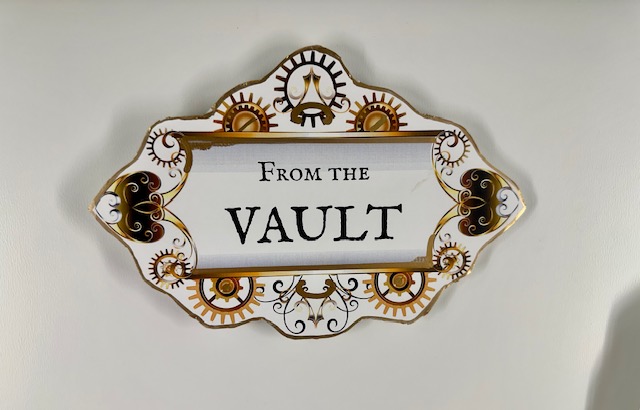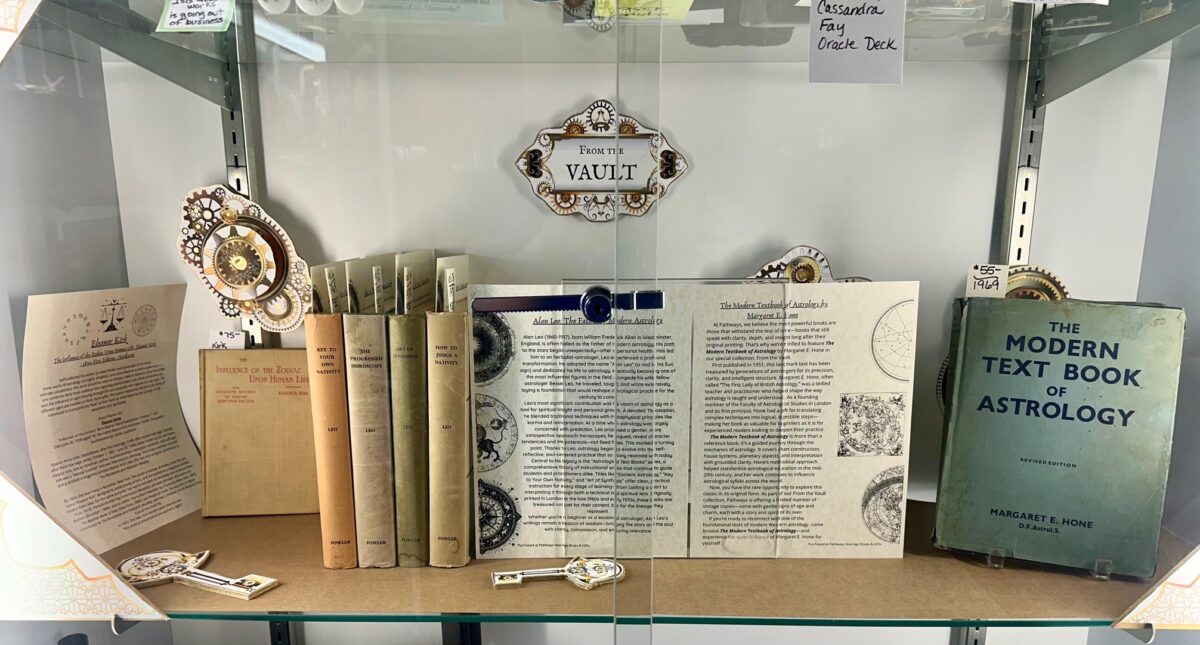

6.28.25 UPDATED!
We now have a Vault #1
& a Vault #2!
Read on below:

Vault #1
Vault #2
In this Vault, we have focused on select, collectible astrology titles. It’s located to the left of our new titles bookshelf. Here’s what’s inside Vault 1: Alan Leo & Eleanor Kirk:
We’re beginning with a cornerstone: Alan Leo. His influence is woven into nearly every modern astrology book that followed. Some call him the father of psychological astrology. Others just call him foundational. These editions, printed in London in the late 1960s and early 1970s, are part of a legacy—clear, sincere, and full of purpose. The kind of books you read with a pencil in hand and a chart on the table.
Alan Leo (1860–1917), born William Frederick Allan in Westminster, England, is often hailed as the father of modern astrology. His path to the stars began unexpectedly—after a personal health crisis led him to an herbalist-astrologer, Leo experienced a profound transformation. He adopted the name “Alan Leo” (a nod to his Sun sign) and dedicated his life to astrology, eventually becoming one of the most influential figures in the field. Alongside his wife, fellow astrologer Bessie Leo, he traveled, taught, and wrote extensively, laying a foundation that would reshape astrological practice for the century to come.
Leo’s most significant contribution was his vision of astrology as a tool for spiritual insight and personal growth. A devoted Theosophist, he blended traditional techniques with metaphysical principles like karma and reincarnation. At a time when astrology was largely concerned with prediction, Leo proposed a gentler, more introspective approach: horoscopes, he argued, reveal character tendencies and life potentials—not fixed fates. This marked a turning point. Thanks to Leo, astrology began to evolve into the self-reflective, soul-centered practice that so many resonate with today.
Central to his legacy is the “Astrological Text Books” series, a comprehensive library of instructional works that continue to guide students and practitioners alike. Titles like “Esoteric Astrology,” “Key to Your Own Nativity,” and “Art of Synthesis” offer clear, practical instruction for every stage of learning—from casting a chart to interpreting it through both a technical and spiritual lens. Originally printed in London in the late 1960s and early 1970s, these books are treasured not just for their content, but for the lineage they represent.
Whether you’re a beginner or a seasoned astrologer, Alan Leo’s writings remain a beacon of wisdom—bridging the stars and the soul with clarity, compassion, and enduring relevance.
The Influence of the Zodiac Upon Human Life – Eleanor Kirk
– 1894 First Edition – Hardcover
Self-published by author (a noted Writer and Spiritualist of the time).
Some works of astrology are highly simplistic, and some dwell on complex ephemera and intricate calculations; this work should be seen as a happy medium between those two poles, and combines fairly basic zodiacal lore regarding relationships, luck, physical features, etc., with the influence of signs moving through the sun especially with regards to cusp signs. The different signs are treated on fairly thoroughly. The author repeatedly alludes to the ability of individuals to transcend the “fate” of their birth by understanding the concept of self-awareness and spirituality.
About Eleanor Kirk
Eleanor Ames
“A Woman of the Century” Born Eleanor Maria Easterbrook October 7, 1831
Died June 20, 1908 (aged 76) Pen name Eleanor Kirk Nickname “Nellie” Occupation
businesswoman, writer, publisher
Eleanor Ames (née, Easterbrook; after first marriage, Child; after second marriage, Hubbell; after third marriage, Ames; October 7, 1831 – June 20, 1908), better known by her pen name, Eleanor Kirk, was an American author, businesswoman, newspaper publisher, and suffragist. Kirk was a “Mental Scientist” and was interested in astrology. She wrote a number of books and published a magazine entitled Eleanor Kirk’s Idea. She was also a regular contributor to
The Revolution and Packard’s Monthly.
By 1860, she was living in Brooklyn, New York. She wrote a number of books under the pen name “Eleanor Kirk” designed to assist young writers, and she published a magazine entitled Eleanor Kirk’s Idea, for the same purpose. Her works included Up Broadway, and its Sequel (New York, 1870), Periodicals that Pay Contributors (Brooklyn; privately printed). Information for Authors (Brooklyn, 1888); and as editor, Henry Ward Beecher as a Humorist (New York, 1887), The Beecher Book of Days (New York, 1886), and Perpetual Youth. She was also a regular contributor to The Revolution and Packard’s Monthly, and was a member of the Woman’s Press Club of New York City.
In 1870, the New York Herald stated that she was
“the most pronounced of the women’s rights”.
In this vault, we have focused on titles by Kenneth & Steffi Grant. It’s located in the case near the Western Magick section. Here’s what’s inside Vault #2
Kenneth Grant (1924–2011) stands as one of the most far-reaching voices in 20th-century occult literature. As head of several Thelemic orders and a close student of Aleister Crowley, his work represents a rare synthesis of Western ceremonial magick, Eastern mysticism, and visionary creativity. His Typhonian Trilogies—a landmark series published between 1972 and 2002—include such seminal titles as The Magical Revival, Nightside of Eden, and Aleister Crowley and the Hidden God. These volumes, long valued by students of the occult, are increasingly scarce and sought-after.
Grant’s engagement with esoteric traditions began early. After discovering Crowley’s Magick in Theory and Practice in 1939, he corresponded with the author and soon joined the Ordo Templi Orientis, later receiving initiation into the A∴A∴ and elevation to IX° in the O.T.O. in 1946. Following Crowley’s death, Grant’s path expanded further through encounters with alchemist and tantric adept David Curwen, who initiated him into a subtle and little-known stream of the vama marg tradition. These experiences informed a lifelong engagement with Advaita Vedanta and Eastern mysticism, reflected in essays later collected in At the Feet of the Guru (Starfire, 2006).
Grant’s connection with visionary artist Austin Osman Spare further enriched his occult philosophy. Acting as Spare’s amanuensis and correspondent, he helped preserve and interpret Spare’s unique magical system, culminating in their collaborative founding of the Zos Kia Cultus in 1954—an expressive current rather than a formal tradition, centered on personal gnosis and magical creativity (Zos Speaks!, Fulgur, 1999).
That same year, Grant established the New Isis Lodge to facilitate contact with what he described as “transplutonic” energies. The lodge remained active until 1962, and its workings are explored throughout the Typhonian Trilogies, which blend autobiographical accounts with ritual commentary and metaphysical speculation.
In tandem with these efforts, Grant and his wife Steffi produced the Carfax Monographs (1959–1963), a ten-part series exploring hidden strands of Western esotericism. These writings laid the foundation for what became a singular, 50-year body of work that continues to challenge, inspire, and provoke serious occult inquiry.
For collectors, scholars, and serious practitioners, Kenneth Grant’s books represent more than literary curiosities—they are gateways into an intricate magical cosmology unlike any other. Many of his titles are long out of print and increasingly difficult to obtain, making them both a valuable addition to any esoteric library and a wise investment for the discerning reader.
